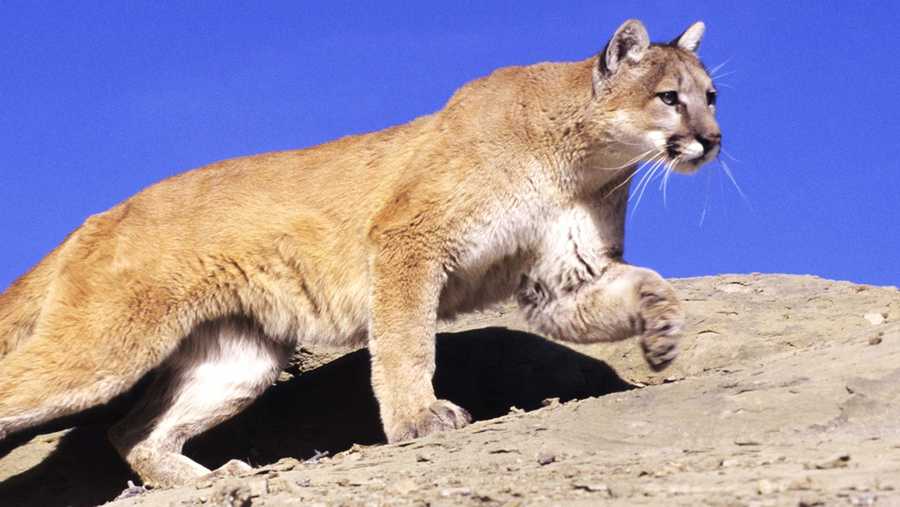2 mountain lions die of apparent starvation in California after relocation by wildlife officials
Two mountain lions who were relocated from their Eastern Sierra Nevada habitat to the Mojave Desert by California Department of Fish and Wildlife officials in 2021 later died of starvation when they attempted to head back “in a straight line” to their home range, forcing them to cross through barren, unfamiliar terrain where they experienced difficulty finding prey.
As the Los Angeles Times first reported, the news came to light when the CDFW released its 2020-21 annual report on the recovery of endangered Sierra Nevada bighorn sheep. At the time, state wildlife officials made the decision to capture and relocate two male cougars — dubbed L147 and L176 — that had been preying on the sheep, transporting them nearly 210 miles to the Mescal Mountains in Arizona.
State wildlife officials later clarified in their 2021-22 report that they had hoped the Mojave Desert would “function as a barrier” to prevent the mountain lions’ return to the Sierra Nevada. Upon their arrival, though, the mountain lions started to make the trek back northwest to California — driven by instinct to find mates in their home range — when they encountered the desert landscape with “patchily distributed food.” L147, who had been taken to the Mescal Range in January, was found dead later that March “in an emaciated condition suggesting starvation.” L176, who had been captured in March, was also “in an extremely emaciated condition and had to be euthanized” later that May.
The decision to move the mountain lions was “primarily motivated by interest in gathering data on wildlife corridors crossing I-15,” state wildlife officials said in their 2020-21 report. They explained one benefit of the mountain lions’ relocation was that both of them utilized separate underpasses to cross Interstate 15, demonstrating the importance of the sources of connectivity for wildlife on major highways. But “more important and practical factors which should influence mountain lion release sites, such as prey availability and habitat familiarity, received less consideration.”
Wildlife advocates were distressed upon hearing the news of the animals’ demise.
“The deaths of the mountain lions noted in the report are tragic, and reading about their deaths made my heart hurt,” Brent Lyles, executive director of the Mountain Lion Foundation, told the LA Times.
“Looking back on the end result,” he added, “I wish they had considered more factors, like habitat suitability for those particular lions. But I’m sure those researchers feel the same way, looking back on their actions in hindsight.”
Zara McDonald, a biologist with the Bay Area Puma Project, which is focused on research and conservation of the region’s mountain lions, said the organization is “firmly against” relocating the big cats, and that the approach could have dire consequences for not only the animals but the delicate ecosystem in which they play a critical role.
“Mountain lions are territorial creatures, intricately attuned to their surroundings,” McDonald told SFGATE in an email. “Relocation can induce immense stress and disorientation, leading to reduced survival rates (such as what occurred with the 2 recent males), limited hunting success, and higher susceptibility to disease due to unfamiliar environments.”
Relocating the animals can also inadvertently introduce conflict to new areas and unintentional clashes with existing populations of other predators, McDonald said. And because mountain lions’ habitats in California are already under “significant pressure” due to factors such as urban sprawl and habitat fragmentation, moving them encroaches upon their native territories and further exacerbates the challenges they face, she said.
When reached for comment, Jordan Traverso, a CDFW spokesperson, shared the department’s 2021-22 bighorn sheep report with SFGATE, which sought to clarify that wildlife officials relocated the mountain lions so they wouldn’t have to be lethally removed after they had been documented hunting down the sheep.
“At the time, CDFW was exploring alternatives to killing lions right there on the spot,” Traverso said in an email. “We regret that these lions died in this manner, and we will learn from it. As the report says, future translocations will benefit from many lessons learned in these cases.”
More mountain lions and bighorn sheep are coexisting than before, Traverso said, noting 55 mountain lions were documented in the Eastern Sierra Nevada last year, exceeding the highest count of 54 in 2021. Bighorn sheep counts are also “high and growing,” with 277 females counted last year; the highest population recorded was 316 in 2016, and wildlife officials are hopeful they will continue to rebound.
The department has since changed its policy on mountain lions and no longer plans to relocate males because of their homing instinct, or proven proclivity to beeline to their home range with the intent of guarding females from other potential mates. Tom Stephenson, a senior environmental scientist at CDFW, told the LA Times the department won’t move the big cats to the Mescal Range again.
The fate of L147 and L176 highlights the conflicting conservation efforts of both animal populations. Sierra Nevada bighorn sheep have made a notable comeback since just six herds numbering 125 total animals were counted in the 1990s, but full recovery is still decades away. Mountain lions have been protected from hunting in California following the 1990 passage of the California Wildlife Protection Act, but McDonald highlighted issues, including reduced habitat and the local extinction of small, isolated populations in parts of the Central Coast and Southern California, that could lead to the animals’ listing as a “threatened” species in those regions under the Endangered Species Act sometime next year.
“The fact is that CDFW manages for bighorn sheep and … mountain lions,” Traverso said. “This part of the state shows a difficult overlap that underscores how incredibly challenging it is to manage for so many cherished species. Management decisions and the lessons learned are the basis of science. It is never easy and it is certainly not perfect.”


